All you need to know about the MiG-29 UPG

“The most advanced is the MiG-29UPG, implemented in India in collaboration with local industry”
These were the words of Sergei Korotkov, the director-general of MiG. It was his reference to the Indian upgrade of MiG-29 to UPGs standard where he directly said that the India MiG-29 UPG is the most advanced variant of Mikoyan Mig-29 ever built. But the journey of MiG-29s with India was not always like this, in fact, India procured these machines when they were in the initial phase of development and today they are one of the most advanced aircraft in the inventory of IAF.

A Mig-29 just about to perform a vertical takeoff Credit- Topfelya
The MiG-29s were originally designed and developed to counter American threats like F-16andF/A-18s and to compliment aircraft like Su-27. However, since their introduction, the aircraft has gone through a series of upgrades all over the world and is one of the most produced aircraft ever built with 1600+ units built by now.
The Indian air force received its first MiG-29B variant in 1986, even after being called a downscaled variant, the MiG-29s could deploy medium-long range BVR missiles that were a nightmare for Pakistani F-16s and prevented them from providing support to ground forces in Kargil, similarly, the MiG-29s were extensively used in Kargil to escort Mirage-2000s in bombing roles.
Here in this article, we would be extensively discussing the technical specifications of MiG-29 UPGs in the simplest manner possible and their importance for the Indian Air Force in modern day:-

The MiG-29 UPG, here armed with R-77 BVR missile. Image Source: RAC MiG
Structure of aircraft-The MiG-29 has Leading edge extension at the point where the wings of the aircraft blends together, this helps the aircraft to attain a high angle of attack even at low airspeeds, it’s for the same reason why LCA Navy also has a similar type of LEVCONs that can be deflected and provide more aerodynamical stability at slow speeds. The aircraft also has a hump on the spine that has significantly increased its internal fuel capacity by around 1 Ton and increased range by 1500 km to 2100 km without external drop tanks. The range is further extended by its capability to carry additional 3 drop tanks and an incorporated retractable refueling probe. The dual air intake of the aircraft is also one of the amazing features of Soviet engineering; the MiG-29 is the first aircraft in the world to have such intakes, it helps the aircraft on rough terrains as when the aircraft is on the ground the intake is shifted to the louvers to prevent any type of ingestion of foreign particles like dust by the engine.
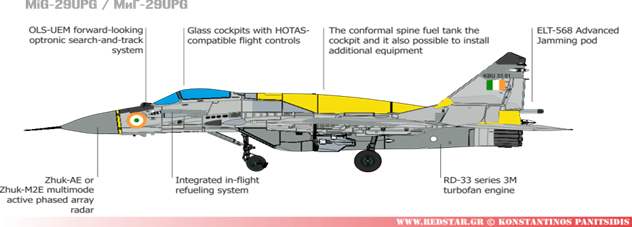 MiG 29 UPG, notice the conformal fuel tank. Image Credit- WWW.REDSTAR.GR
MiG 29 UPG, notice the conformal fuel tank. Image Credit- WWW.REDSTAR.GR
Engine-The MiG-29 UPG is powered by two RD-33 series 3 engines with better thrust, service life, and comparatively less smoke than baseline versions. The RD-33 series 3 engines can generate a maximum thrust of 81+ kNs afterburner with the dry thrust of 50 kN, further, the engine is said to have an expected life of 4000 hours. The engine has systems like a failure detection system, compressor speed governors, and an automated diagnostic system based on a PC for quick technical evaluation of the engine by ground crew. The aircraft even has one of the best thrust to weight ratio because of the ultimate power of RD-33 engines that makes it even more agile apart from its unstable aero dynamical structure, no wonder why the aircraft is repeatedly seen to do amazing vertical takeoffs so easily and have specifications like the maximum speed of 2400 km/h and an amazing rate of climb of 330 m/s.
 A MiG-29 of Polish Air force showcasing the full throttle of RD-33 engines
A MiG-29 of Polish Air force showcasing the full throttle of RD-33 engines
Radar-The radar is the Zhuk M pulse doppler electronically scanned array radar. The radar has quicker processing power, can detect 5m2 objects from 120 km, and can track 10 targets with the capability to engage 4 targets at once in the air to air mode. The radar further provides coverage of +/-85 degrees in azimuth (sideway coverage) and +56/-40 degree in elevation and is also capable of detecting and tracking air to surface threats at remarkable distances. The MiG-29 UPG is also rumored to be equipped with AESA radar, especially since these rumors rose around the period when India signed a deal for an additional 21 MiG-29 UPGs, the real possibility of MiG-29 having AESA radar are quite debatable because of comparatively higher electrical consumption of AESA radars, however, it is still possible with GaN variants of Zhuk radar-like FGA-35 or with other lower electrical consumption radars.
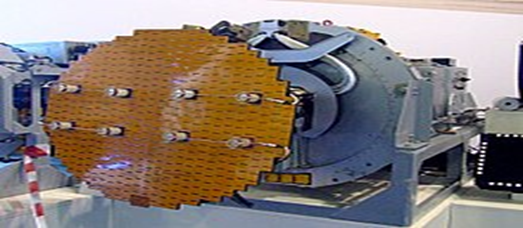
Zhuk-ME Radar. Image Source: Wikipedia
Optical locating system- The Optical locating system is quite important for an aircraft, that’s because when aircraft try to detect their targets from Radar, its possible that the enemy gets alerted from electromagnetic radiation of radar through a Radar warning receiver and try to avoid that detection either through getting away from coverage area or by performing some maneuvers. The OLS here plays an important role as it doesn’t emit any electromagnetic radiation of their own and hence are quite difficult to detect, it can be really useful for stealth targets. The MiG-29 has an OLS-UEM system consisting of a 320×256-pixel infrared sensor and a 640×480-pixel TV camera achieving the infrared search and track (IRST) capability during air-to-air engagements. Besides, a laser rangefinder helps to know the distance from the target with high accuracy at ranges between 200 meters to 20 kilometers. The OLS-UEM can detect airborne targets at a distance of 15-55 km with coverage of +/-90 degrees in azimuth (sideways) and +60/-15 degrees in elevation.

The Optical Locating system-UEM. Image Source: Wikipedia
Avionics & Cockpit– The cockpit of MiG-29 UPG is now HOTAS (Hands-on throttle and stick) Capable with a new Head-up display and a partial glass cockpit with two main Multifunctional displays where most of the information regarding aircraft is showcased. The aircraft has a French Safran Sigma N 95 Navigation system with new video recorders and map generators. The aircraft is also seen with pilots wearing different Helmet mounted displays that vary from Thales Topsight HMD in MiG-29K to Israeli Dash HMD and Russian Shchel 3UM HMD.
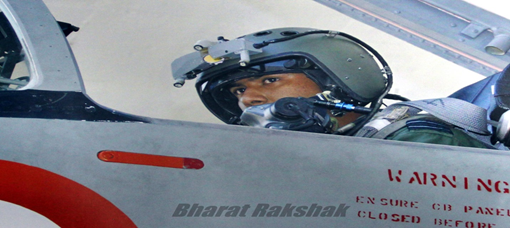 Shchel 3UM HMD.
Shchel 3UM HMD.
Electronic Warfare Suite– The MiG-29 is the only aircraft in IAF after Dassault Rafale to have an internal EW Suite. The D-29 EW suite of Mig-29 UPG is made by DRDO’s Defence avionics research establishment lab, Israeli Elisra, and Italian Electronica. The D-29 is a fifth-generation AESA based EW suite consisting of a Radar warning receiver, electronic support measure, and other electronic countermeasures. The ELT 568 Jamming system onboard are defensive in nature and are used to jam SAM’s and AAM’s launched towards aircraft, they are said to be effective on frequencies between 6-18 GHz by using an active phased array, further the EW Suite can alert of any digital frequency between 1-18 GHz. Jamming works on a cross-eye principle where artificially fake targets are created for the enemy to engage in them, such type of jamming is quite difficult to overcome. The D-29 consists of a Unified Receiver Exciter Processor (UREP modified to suit the requirements of D-29), Solid State Transmit / Receive Unit (SSTRU) with Active Array Unit (AAU), and a liquid cooling system. In simple terms, the D-29 EW suite in MiG-29 UPG works as a primary self-protection jammer and increases situational awareness by multiple folds.

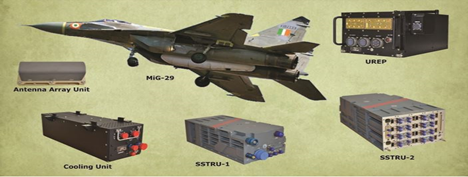
Components constituting the D-29 EW suite. Image Credit –DRDO Official Website
Armament– The MiG-29s are able to carry 4000 kgs of munitions under its 7 hardpoints with a 30 mm Gryazev shipunov Gsh 30-1 autocannon having 150 rounds. The MiG-29s after getting the upgrade is capable of being equipped with R-77 active radar homing beyond visual range missile with a range of 80-100 km, the aircraft can also fire different variants of semi-active radar homing R-27 missiles with ranges varying from 40-130 km. The MiG-29 also carries close-range R-73 Infrared guided missiles that are the same missile from which IAF MiG-21 bison shot PAF F-16, the combination of the R-73 and OLS-UEM can literally be fatal for any stealth adversary. The plans for the integration of indigenous Astra MK-1 BVR missiles are also on paper. The aircraft can further carry heavy guided munitions like Kh-31 that can be used for SEAD roles and anti-shipping roles with munitions like OFAB 100 and other 500 kgs bombs and has the ability to be equipped with Sudarshan LGB and BrahMos NG in the future.
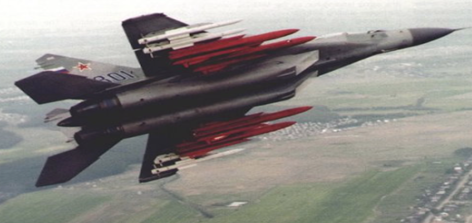
A Russian MiG 29 K Armed to teeth with 4xKh-31 missiles and 4xR-77 missiles. Image Credit- Navy Recognition
Why MiG 29 UPG Matters?
Earlier, the roles of MiG-29s were confined to air superiority, and these assets were focused more on our Western border, however recently during the 2020 India-China skirmish we saw MiG-29 UPGs conducting a series of sorties from Leh airbase in Ladakh. The MiG-29 UPGs was also recently recognized as “Dragonslayers” on-air force day. The reason for MiG-29 UPGs being extremely effective against Chinese counterparts especially in the region of Ladakh is the abnormal flight characteristics at such a high altitude and the electronic warfare superiority it inherits from the D-29 EW suite. A region like Ladakh is situated at quite a high altitude which means that the air density is quite less that creates problems in the proper lift of aircraft, especially the Chinese which uses quite a heavy aircraft like J-11 and even from the Indian Side the Su-30s, won’t prove to be that effective in the region where medium-weight aircraft like MiG-29 and Rafale can dominate easily. The thrust to weight ratio of an aircraft like J-11 is 1, which will obviously reduce in regions like Ladakh and Tibet, that in turn wouldn’t even able the aircraft to fly with all equipped hardpoints and make it to perform aggressive maneuvers to dodge missiles, at the same time the thrust to weight ratio of MiG-29s are around 1.11 which would also reduce in such terrains, but still, it would be enough for an aircraft like MiG-29 to fly with all equipped hardpoints with adequate fuel and perform aggressive maneuvers to dodge the missile, and with this, all comes to the instantaneous power generating capability of RD-33 engines. The MiG-29 UPG as told earlier also has the advantage of a new radar combined with quite a powerful and advanced next-generation EW suite that is unmatched with any other Chinese counterparts.
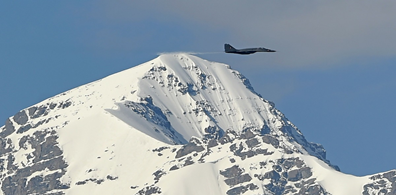
Mig-29 UPG is Soaring high in Ladakh. Image Credit: IAF
There are several other incidences as well which apart from the professionalism and experience of IAF’s pilot also showcase the handling capabilities of MiG-29, one such was in 2011 where Sqn Ldr Ajit Bhaskar Vasane witnessed a thick black smoke in the cockpit that completely blocked his visuals, that too in Gujarat near the area where world’s largest Oil refinery is located, despite being the first incidence of its own kind Sqn Ldr Ajit Bhaskar was successfully able to land the aircraft at Jamnagar airbase with help of audio communication and his wingman who was also flying MiG-29. The MiG-29 UPG has also participated in Exercise eastern bridge with Oman, where they got a chance to compete with Eurofighter Typhoon and F-16s. It indeed wouldn’t be wrong to say that from Kargil to Ladakh, the MiG-29 “Baaz” have become the MiG-29 UPG “Baazigars”.
About the Author: Pratisht Chaudhry. The views expressed are the author’s own. Twitter: @Pratisht3

“The most advanced is the MiG-29UPG, implemented in India in collaboration with local industry”
These were the words of Sergei Korotkov, the director-general of MiG. It was his reference to the Indian upgrade of MiG-29 to UPGs standard where he directly said that the India MiG-29 UPG is the most advanced variant of Mikoyan Mig-29 ever built. But the journey of MiG-29s with India was not always like this, in fact, India procured these machines when they were in the initial phase of development and today they are one of the most advanced aircraft in the inventory of IAF.

A Mig-29 just about to perform a vertical takeoff Credit- Topfelya
The MiG-29s were originally designed and developed to counter American threats like F-16andF/A-18s and to compliment aircraft like Su-27. However, since their introduction, the aircraft has gone through a series of upgrades all over the world and is one of the most produced aircraft ever built with 1600+ units built by now.
The Indian air force received its first MiG-29B variant in 1986, even after being called a downscaled variant, the MiG-29s could deploy medium-long range BVR missiles that were a nightmare for Pakistani F-16s and prevented them from providing support to ground forces in Kargil, similarly, the MiG-29s were extensively used in Kargil to escort Mirage-2000s in bombing roles.
Here in this article, we would be extensively discussing the technical specifications of MiG-29 UPGs in the simplest manner possible and their importance for the Indian Air Force in modern day:-

The MiG-29 UPG, here armed with R-77 BVR missile. Image Source: RAC MiG
Structure of aircraft-The MiG-29 has Leading edge extension at the point where the wings of the aircraft blends together, this helps the aircraft to attain a high angle of attack even at low airspeeds, it’s for the same reason why LCA Navy also has a similar type of LEVCONs that can be deflected and provide more aerodynamical stability at slow speeds. The aircraft also has a hump on the spine that has significantly increased its internal fuel capacity by around 1 Ton and increased range by 1500 km to 2100 km without external drop tanks. The range is further extended by its capability to carry additional 3 drop tanks and an incorporated retractable refueling probe. The dual air intake of the aircraft is also one of the amazing features of Soviet engineering; the MiG-29 is the first aircraft in the world to have such intakes, it helps the aircraft on rough terrains as when the aircraft is on the ground the intake is shifted to the louvers to prevent any type of ingestion of foreign particles like dust by the engine.

Engine-The MiG-29 UPG is powered by two RD-33 series 3 engines with better thrust, service life, and comparatively less smoke than baseline versions. The RD-33 series 3 engines can generate a maximum thrust of 81+ kNs afterburner with the dry thrust of 50 kN, further, the engine is said to have an expected life of 4000 hours. The engine has systems like a failure detection system, compressor speed governors, and an automated diagnostic system based on a PC for quick technical evaluation of the engine by ground crew. The aircraft even has one of the best thrust to weight ratio because of the ultimate power of RD-33 engines that makes it even more agile apart from its unstable aero dynamical structure, no wonder why the aircraft is repeatedly seen to do amazing vertical takeoffs so easily and have specifications like the maximum speed of 2400 km/h and an amazing rate of climb of 330 m/s.

Radar-The radar is the Zhuk M pulse doppler electronically scanned array radar. The radar has quicker processing power, can detect 5m2 objects from 120 km, and can track 10 targets with the capability to engage 4 targets at once in the air to air mode. The radar further provides coverage of +/-85 degrees in azimuth (sideway coverage) and +56/-40 degree in elevation and is also capable of detecting and tracking air to surface threats at remarkable distances. The MiG-29 UPG is also rumored to be equipped with AESA radar, especially since these rumors rose around the period when India signed a deal for an additional 21 MiG-29 UPGs, the real possibility of MiG-29 having AESA radar are quite debatable because of comparatively higher electrical consumption of AESA radars, however, it is still possible with GaN variants of Zhuk radar-like FGA-35 or with other lower electrical consumption radars.

Zhuk-ME Radar. Image Source: Wikipedia
Optical locating system- The Optical locating system is quite important for an aircraft, that’s because when aircraft try to detect their targets from Radar, its possible that the enemy gets alerted from electromagnetic radiation of radar through a Radar warning receiver and try to avoid that detection either through getting away from coverage area or by performing some maneuvers. The OLS here plays an important role as it doesn’t emit any electromagnetic radiation of their own and hence are quite difficult to detect, it can be really useful for stealth targets. The MiG-29 has an OLS-UEM system consisting of a 320×256-pixel infrared sensor and a 640×480-pixel TV camera achieving the infrared search and track (IRST) capability during air-to-air engagements. Besides, a laser rangefinder helps to know the distance from the target with high accuracy at ranges between 200 meters to 20 kilometers. The OLS-UEM can detect airborne targets at a distance of 15-55 km with coverage of +/-90 degrees in azimuth (sideways) and +60/-15 degrees in elevation.

The Optical Locating system-UEM. Image Source: Wikipedia
Avionics & Cockpit– The cockpit of MiG-29 UPG is now HOTAS (Hands-on throttle and stick) Capable with a new Head-up display and a partial glass cockpit with two main Multifunctional displays where most of the information regarding aircraft is showcased. The aircraft has a French Safran Sigma N 95 Navigation system with new video recorders and map generators. The aircraft is also seen with pilots wearing different Helmet mounted displays that vary from Thales Topsight HMD in MiG-29K to Israeli Dash HMD and Russian Shchel 3UM HMD.

Electronic Warfare Suite– The MiG-29 is the only aircraft in IAF after Dassault Rafale to have an internal EW Suite. The D-29 EW suite of Mig-29 UPG is made by DRDO’s Defence avionics research establishment lab, Israeli Elisra, and Italian Electronica. The D-29 is a fifth-generation AESA based EW suite consisting of a Radar warning receiver, electronic support measure, and other electronic countermeasures. The ELT 568 Jamming system onboard are defensive in nature and are used to jam SAM’s and AAM’s launched towards aircraft, they are said to be effective on frequencies between 6-18 GHz by using an active phased array, further the EW Suite can alert of any digital frequency between 1-18 GHz. Jamming works on a cross-eye principle where artificially fake targets are created for the enemy to engage in them, such type of jamming is quite difficult to overcome. The D-29 consists of a Unified Receiver Exciter Processor (UREP modified to suit the requirements of D-29), Solid State Transmit / Receive Unit (SSTRU) with Active Array Unit (AAU), and a liquid cooling system. In simple terms, the D-29 EW suite in MiG-29 UPG works as a primary self-protection jammer and increases situational awareness by multiple folds.


Components constituting the D-29 EW suite. Image Credit –DRDO Official Website
Armament– The MiG-29s are able to carry 4000 kgs of munitions under its 7 hardpoints with a 30 mm Gryazev shipunov Gsh 30-1 autocannon having 150 rounds. The MiG-29s after getting the upgrade is capable of being equipped with R-77 active radar homing beyond visual range missile with a range of 80-100 km, the aircraft can also fire different variants of semi-active radar homing R-27 missiles with ranges varying from 40-130 km. The MiG-29 also carries close-range R-73 Infrared guided missiles that are the same missile from which IAF MiG-21 bison shot PAF F-16, the combination of the R-73 and OLS-UEM can literally be fatal for any stealth adversary. The plans for the integration of indigenous Astra MK-1 BVR missiles are also on paper. The aircraft can further carry heavy guided munitions like Kh-31 that can be used for SEAD roles and anti-shipping roles with munitions like OFAB 100 and other 500 kgs bombs and has the ability to be equipped with Sudarshan LGB and BrahMos NG in the future.

A Russian MiG 29 K Armed to teeth with 4xKh-31 missiles and 4xR-77 missiles. Image Credit- Navy Recognition
Why MiG 29 UPG Matters?
Earlier, the roles of MiG-29s were confined to air superiority, and these assets were focused more on our Western border, however recently during the 2020 India-China skirmish we saw MiG-29 UPGs conducting a series of sorties from Leh airbase in Ladakh. The MiG-29 UPGs was also recently recognized as “Dragonslayers” on-air force day. The reason for MiG-29 UPGs being extremely effective against Chinese counterparts especially in the region of Ladakh is the abnormal flight characteristics at such a high altitude and the electronic warfare superiority it inherits from the D-29 EW suite. A region like Ladakh is situated at quite a high altitude which means that the air density is quite less that creates problems in the proper lift of aircraft, especially the Chinese which uses quite a heavy aircraft like J-11 and even from the Indian Side the Su-30s, won’t prove to be that effective in the region where medium-weight aircraft like MiG-29 and Rafale can dominate easily. The thrust to weight ratio of an aircraft like J-11 is 1, which will obviously reduce in regions like Ladakh and Tibet, that in turn wouldn’t even able the aircraft to fly with all equipped hardpoints and make it to perform aggressive maneuvers to dodge missiles, at the same time the thrust to weight ratio of MiG-29s are around 1.11 which would also reduce in such terrains, but still, it would be enough for an aircraft like MiG-29 to fly with all equipped hardpoints with adequate fuel and perform aggressive maneuvers to dodge the missile, and with this, all comes to the instantaneous power generating capability of RD-33 engines. The MiG-29 UPG as told earlier also has the advantage of a new radar combined with quite a powerful and advanced next-generation EW suite that is unmatched with any other Chinese counterparts.

Mig-29 UPG is Soaring high in Ladakh. Image Credit: IAF
There are several other incidences as well which apart from the professionalism and experience of IAF’s pilot also showcase the handling capabilities of MiG-29, one such was in 2011 where Sqn Ldr Ajit Bhaskar Vasane witnessed a thick black smoke in the cockpit that completely blocked his visuals, that too in Gujarat near the area where world’s largest Oil refinery is located, despite being the first incidence of its own kind Sqn Ldr Ajit Bhaskar was successfully able to land the aircraft at Jamnagar airbase with help of audio communication and his wingman who was also flying MiG-29. The MiG-29 UPG has also participated in Exercise eastern bridge with Oman, where they got a chance to compete with Eurofighter Typhoon and F-16s. It indeed wouldn’t be wrong to say that from Kargil to Ladakh, the MiG-29 “Baaz” have become the MiG-29 UPG “Baazigars”.
About the Author: Pratisht Chaudhry. The views expressed are the author’s own. Twitter: @Pratisht3
Last edited:








